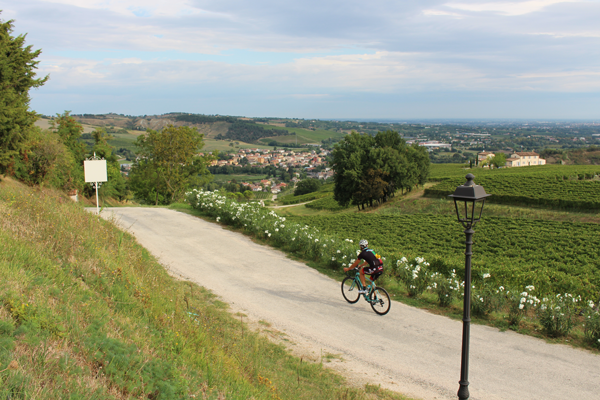With centuries of history, quiet roads and testing climbs, cycling runs in the blood of Emilia Romagna. Words and photography Iain Treloar.
Out my aeroplane window, jagged peaks stretch toward the sun, their heads poking through the cloud. Tiny villages nestle on the shores of lakes, or in Alpine valleys. Kilometres below me, a run of switchbacks traces a faint vein up the side of a mountain. I imagine ascending its curves and cambers, and my travel-puffed legs twitch in anticipation.
As we near Bologna airport, the terrain softens. We come in to land over a patchwork quilt of vineyards, olive trees and white farmhouses with terracotta roofs. It’s an unseasonably warm late summer, with temperatures in the thirties; the glare is intense and as I walk onto the tarmac I’m hit by a heavy wave of humidity. Coming from a bleak Melbourne winter, the contrast is a shock to the system.
I’ve come to ride the roads of Emilia Romagna, a region bordering more famous neighbours Tuscany, Lombardy and Veneto. If you’ve not heard of the place, you’ve certainly heard of its culinary and automotive exports, among them balsamic vinegar and Sangiovese, Ferrari and Lamborghini, Parmigiano Reggiano and Parma ham.
Of course, it’s not just a region for petrolheads and gastronomes. Being Italy, there’s thousands of years of history around you. Even the smallest towns, which you’d half expect to be sad dead-end kind of places, have an idyllic charm. To the south and west of the region, along the spine of the country, there are proper mountains. Towards the east, where I’ll be heading, vineyards cover the hills as they roll down to the long, white-sand beaches of the Adriatic Riviera. For the next five days and 500 kilometres I’ll be riding through this landscape, exploring the climbs and the countryside of Emilia Romagna. Tough job, but someone’s gotta do it.
The TerraBici experience
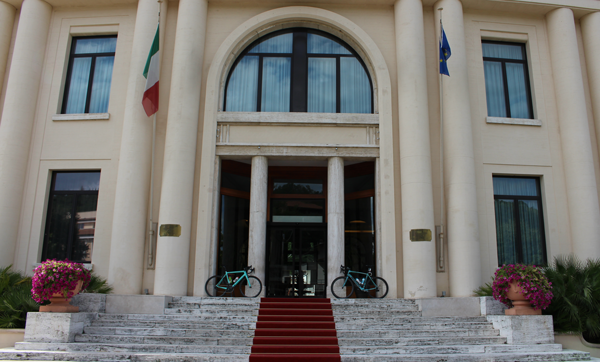
Italy’s got a long and impressive tradition as a cycling nation, and it’s a combination of heritage, geography and amenity that has led to the country becoming a sought-after destination for international visitors—a fact especially true of Emilia Romagna. A recent development in the region has been the creation of a group called TerraBici. This is a consortium of hotels with a particular focus on the needs of bike riders, and during tourist season, from March to October, cyclists are a vital cog in their business.
Picture this; you, like me, have just arrived from Australia. You’ve travelled a long way, but you’re keen to explore the region by bike. Maybe you’ve brought your own; maybe you’ve been stymied by baggage restrictions and would like to rent one. You’re sure there are an abundance of great routes to ride in the countryside, but you’re almost certain to get lost, or otherwise waste hours on Google Streetview in search for that elusive perfect road. Perhaps you want to travel around, but you’re stumped about how to get your luggage from place to place. And, more likely than not, you’re dealing with a language barrier, and gestures can only get you so far if you’re trying to nut out the specifics of whether that stretch of Via Sbaraglio is good for bikes or choked with trucks.
This is where TerraBici can help. It’s a collaborative business model, where participating hotels have banded together to grow cycling in the region, benefiting from the strength in numbers that come as a result. The hotels offer free daily guided rides for a wide range of abilities, provide bike hire—anything from beach-cruising fat bikes to high-spec Pinarellos—and usually there is secure bike storage and repair facilities on site. Should you wish to hop around the region by bike, you can do that too; TerraBici teleport your luggage to the next stop so you can ride more and fuss less about the logistics.
Part of the strength of the TerraBici offering is that their concept is broader than just a hardcore road riding holiday (although it can certainly be that if you wish). Riding in Emilia Romagna is a multisensory experience that transcends mere kilometres; it’s also about the region’s famous hospitality, food, wine, history and scenery. As such, whilst your day’s ride might be 100km with 1,500m of climbing, your guide is just as likely to include a stop at a winery for a long lunch.
TerraBici hotels are usually clustered around the towns and cities stretching along the coast, with Riccione and Rimini the most prominent. This is a hangover from the days where beach and bike-loving German tourists awakened hoteliers to the idea that a concerted effort in cyclotourism might make good financial sense.
Now, it’s not just the hotels who put on a show for bike riders, but the whole region. Tourist offices along the coast are well-equipped to deal with enquiries, offering excellent maps and ride notes in a range of languages. The province of ForliCesena has a particularly impressive offering, with jersey-pocket sized route cards printed on sweat-resistant paper. And, with a lot of cyclists on the road, conditions are usually pretty good apart from the occasional pothole, and drivers are generally respectful.
The coast
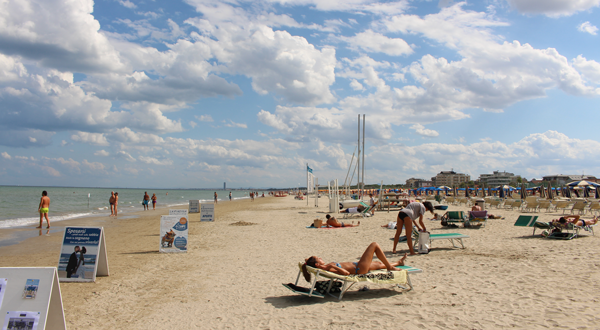
The Adriatic Riviera runs more or less up to Venice, but in Emilia Romagna, from Ravenna down to Cattolica, there’s a stretch of about 70km of continuous white sand beach. Behind this, there’s a band of thousands of hotels; 3,000 from Riccione to Ravenna alone. That’s a lot of accommodation.
For an Australian, the Italian beach experience is uncomfortable in its orderliness. Umbrellas stretch left and right down the coast, as far as the eye can see, their retreat from the ocean thwarted by the hotels blocking them in. Beach-chairs are lined with military precision. If Australian summer feels freerange—sandcastles and sprawling families, barbecues and beach cricket—this is the battery equivalent and made me feel a tad claustrophobic.
Hotels and private operators own sections of the beach, charging an entrance fee for access to the facilities on offer. Often, the facilities to entice visitors are impressive; Fantini Club in Cervia, for instance, has beach volleyball courts, bars and restaurants, spa facilities and, on the day I visited, even hosted a calisthenics exhibition. Elsewhere on the coast, I spotted family-friendly water slide parks, private pools and day-spas.
While the beachside suburbs may lack a little in old-world charm, each town has a historic heart. The centre of Rimini, a couple of kilometres in from the coast, is well preserved and gorgeous. 2000yearold bridges built by the Romans still provide access from the northwest over the Marecchia River, and the narrow arcades open up into the vast Piazza Cavour. In the mild early-evening, I’m surrounded by hundreds of Italians elegantly gliding by, swivelheaded Casanovas and friends catching up for aperitifs.
Italians love the good life, and with their well-heeled, charismatic presence everywhere around me this evening, I’m envious. What equivalent do we have in Australia? Neck a few stubbies in a crappy pub built in the sixties? No comparison. After finishing our Aperol spritzes, we stroll toward dinner a few streets away. I ask about a new building on the right, all windows and angles, with boardwalks and floodlighting over a tiled floor. This, I’m casually told, is the visitor centre to a Roman villa, accidentally unearthed during construction works a couple of years back. Its foundations stand strong even now.
There are a few more unexpected sights to be seen by the seaside. The coastal flats just behind Cervia are vast saltpans, frequented by flocks of flamingoes mid-migration. When I rode through, sadly, they were off doing flamingo-things (honking? being pink?) elsewhere, and I missed out on seeing them, but knowing of their existence on the Italian coast alone was a pleasing surprise.
One stunning section of road—the Panoramica Adriatica, from Cattolica through to Pesaro—wound appealingly through the regional park of Monte San Bartolo, climbing from beachside to gorgeous views back along the coast at Gabicce Monte. It was a rare diversion from the kilometres-long stretch of umbrellas, and it became my favourite section of the coast during my days in Italy. But for me, the beachside towns weren’t necessarily a riding destination in and of themselves. They were, however, a great base to explore the real star of the region—its hills.
Apennine foothills
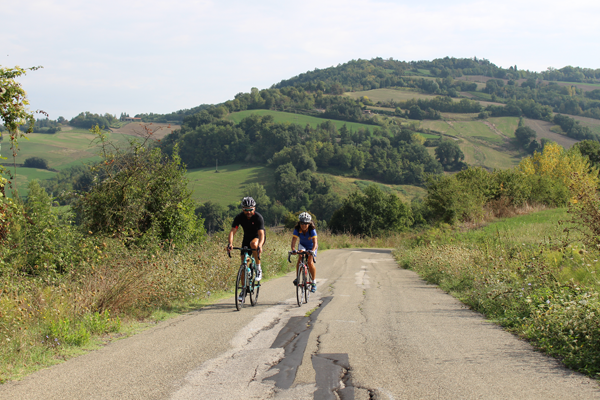
Within 20km of the coast, you’re deep in the foothills of the Apennines, where everything feels a little more authentic. My second day’s ride took me from Rimini in an arching loop to Fratta Terme; slowly reeling in the cliff-top citadels of San Marino, skirting its border and climbing to Verucchio. The pinch to its high point is tough going in the heat—3km at a gradient of 6%—but the view’s worth it, and the town square at the top is a lovely place to catch your breath. The 12th century castle and convent add a pleasing diversion for history buffs.
Small towns like this—rich in history, abundant in beauty—are common throughout the region, and there’s a resurgence in the appreciation of them. Sogliano al Rubicone, for instance, is known for its Fossa cheese, uniquely aged in pits in the ground for up to three months. A few kilometres up the road, at the top of a very nasty little climb with a maximum gradient of about 20%, is the town of Strigara Castello. Actually, ‘town’ is a bit of a stretch; there’s just one inhabitant keeping company with the 14th century church. But rather than letting the town disappear into the past, a successful restaurant and bar called Fossa Blues has recently opened; now, monthly live music rings out in the square, and there’s a steady stream of visitors to sample the local produce.
Everywhere in Italy, you’re surrounded by history. In Predappio however, where I stop for a night, the history is neither classical or Roman; the town was the birth and final resting place of Fascist dictator Benito Mussolini. The run into Predappio is along an elm-treelined boulevard, opening up into a cobbled central square, with the blocky, symmetrical architecture typical of the Fascist era. Mussolini’s fingerprints are all over the region; that morning we’d set off from a vast spa hotel in the town of Fratta Terme that dominates the town, a place frequented by Mussolini and his family.
Dictators need pampering too, I guess.
The spa, with its long and impressive history, is a grand edifice; now its 70 staff attend to physio and massage in addition to all the usual business of a hotel. Fun bonus fact: they’ve also got the contract to provide rehabilitation for astronauts returning from space.
Just up the road, on the top of a steep and narrow climb, is the beautiful medieval town of Bertinoro. We swing by for dinner, but it’s not the tranquil oasis I’d imagined. My arrival coincides with the annual hospitality festival and the town square is home to a big stage and a brass-band playing Chemical Brothers mashups, with German retirees going nuts in an ecstatic trance of too much sun and too much Sangiovese. We eat at a restaurant called Ca’ de Bè, one floor below the town square, with views along the entire coast. The food’s good; the wine is great. Down the hill at the hotel, I sleep a dreamless sleep, and rise refreshed for another big day in the saddle.
The climbing
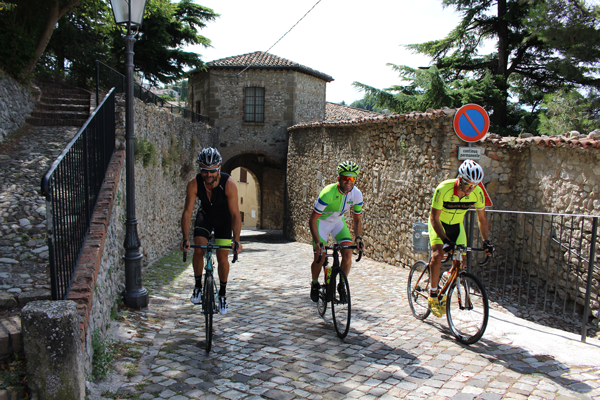
Despite doing a lot of climbing, we don’t reach massive altitudes. The climbs are relatively brief (usually below 7km) and we max out at 760m altitude on the Passo del Carnaio—no hulking 20km behemoths here. It’s far from easy going, though; it is gradient, not length, that poses the greatest challenge. We spend more time above 10 per cent than I have in my life before, and it’s not unusual to hit 20 per cent on switchbacks.
Over my five days of riding, we tackle several challenging but rewarding climbs. The climb to Ciola, from both sides, is a beautiful ascent. It helps that the weather puts on a show, with sunshine filtering through the trees over the road casting everything in a gorgeous gold-green glow. Pieve di Rivoschio is a very different beast; quite exposed and barely used by cars, it traces a ridge with views of canyons to the right and valleys to the left. It’s on this ridgeline that a storm rolls in, the only rain of my whole trip. Fat drops splash off my helmet and wash the salt and sunscreen off my arms. I’m ludicrously happy to be here in the middle of nowhere, with views like these and a thick wall of bruised grey clouds scudding in from the horizon. After the descent, a valley over, we’re back in bright sunshine and I finish drying off with an espresso in the town square of Mercato Seraceno.
Then there’s the little side roads which aren’t widely used enough to get a name or a reputation. The climbs just before reaching Fratta Terme don’t even show up in Strava, but are spirit-sappingly steep and some of the greatest topographical challenges of the entire trip. Perhaps the fact that my guide for the day, Daniele, is a little guy who looks like Roberto Heras and climbs like Purito Rodriguez makes me feel slower than I actually am. It’s probably a good thing I’ve got Daniele to ride with—he provides a bit of tough love that helps condition me for my final ride in Italy, a Gran Fondo.
Gran Fondo experience
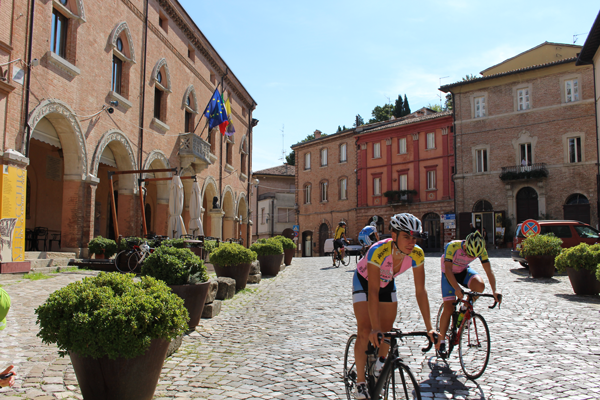
Italians invented the Gran Fondo, a type of semi-competitive timed road ride that has become a favoured format for mass-participation riding events around the world. The Gran Fondo season in Emilia Romagna is particularly dense, with events almost weekly from March to October. The oldest and most famous of these—and one of the largest globally—is Nove Colli, held in late May by the Fausto Coppi cycling club in Cesenatico. It’s vast in scale, reasonably priced and hugely popular; although capped at 12,000 riders, it sells out fast (10,000 tickets were snapped up in just twenty minutes this year) and is a massive boon to the local economy. Riders have the option of a long route (210km over nine climbs totalling 3,840 vertical metres) and a short route (130km, four climbs and 1,870 vertical metres).
I participate in the somewhat less crowded Pantanissima Gran Fondo, an event run by the Marco Pantani Foundation in his memory, attracting just over a thousand participants. It’s bloody hard. The mass start through the streets of Cesenatico is briskly paced, full of roundabouts and the squealing of brakepads on carbon. It’s the closest I’ve encountered to road racing outside of a race, and I’m spooked, passed on the left and the right by quicker riders announcing their presence in a language I don’t understand. Although it’s hugely exciting, after taking the first flat 20km at almost 40 km/h, I’m relieved when the road pitches upwards and I can ride at my own pace. The climbs wind through post-cardworthy scenery, a panorama of vineyards and distant peaks and rolling hills. I would have loved to have taken a moment to sit up and enjoy the landscape but I was too busy trying to get my yammering heart rate back under control, so, no happy snaps from the Gran Fondo. Sorry. Finally there’s a rest-stop at the top of Monte Vecchio and I clip out to take a look at the spread.
The food and beverages supplied on Italian Gran Fondos are a little more gourmet than you’d typically encounter in Australia. Rather than energy bars and gels, there’s more of a focus on ‘real’ food—squares of pizza, jam on bread, bananas and nectarines, fruit juices, even apple pie.
If the food implies a leisurely picnic, the riding is anything but. The shorter course of the Gran Fondo Pantanissima takes in three climbs and almost 2,000m of climbing over 120km, and when not going uphill we’re still strung out in a pace-line sitting at 40km/h in the flat bits. I’m one of the slow ones and it still feels quick.
I’m told that the bigger Gran Fondos have a wider spread of rider abilities and that the participants in the Pantanissima were a well-trained lot, but maybe my charming hosts, Andrea and Fred, were being courteous. Either way, it was pretty addictive. Once I’d finished feeling sorry for myself I even caught myself wishing I had a calendar of these crazy, intense rides to participate in back at home.
A curiosity about Gran Fondos in Italy is that a medical check is required before participation for the organisers’ insurance purposes. I’d recommend organising this back home if you’re planning on taking part in one. My Italian quest to get a last-minute doctor’s tick of approval was highly entertaining in a surreal kind of a way, although a little stressful.
Cesenatico provides the coda to my time in Emilia Romagna. It’s a small town of 30,000 with a population that swells tenfold in the summer. At its centre is a harbour designed by Leonardo da Vinci, with historic boats that will never sail again walled into the inlet by a stone bridge.
A long pier stretches into the Adriatic, the sea glistening cheerfully in the sun. As I slowly stroll to its end, I’m hit with a wave of sadness that my time in Emilia Romagna has also come to an conclusion. I’ve learnt the region is great for bike riders, but there’s a hospitality and warmth to the people that I wasn’t expecting. It’s a land rich in history but it’s not resting on past glories; la dolce vita is now.
For more on cycling in Emilia Romagna, see terrabici.com and emiliaromagnaturismo.com
Thanks to all those I rode with, ate with and met with.
Ride On’s trip to Italy was hosted by Emilia Romagna Region Tourist Board and TerraBici.
Ride On content is editorially independent, but is supported financially by members of Bicycle Network. If you enjoy our articles and want to support the future publication of high-quality content, please consider helping out by becoming a member.

